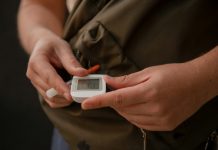
Exposure to air pollution, even in our own homes, can increase the risk of developing insulin resistance, a pre-diabetic state that can lead to type 2 diabetes.
This important finding was reported by scientists from Helmholtz Zentrum München and the German Center for Diabetes Research (DZD) in the journal Diabetes.
In their study, the researchers analyzed data from nearly 3,000 participants living in the city of Augsburg and nearby rural areas.
The participants underwent interviews, physical examinations, and blood tests to assess their insulin resistance and inflammation levels.
The researchers also examined a hormone called leptin, which has been linked to insulin resistance. Non-diabetic individuals also took a glucose tolerance test to assess their glucose metabolism.
To understand the impact of air pollution, the scientists compared the participants’ health data with air pollutant concentrations around their homes. They used predictive models based on measurements taken at multiple sites in the city and rural areas.
The results revealed a concerning trend: individuals with pre-diabetes, a condition where glucose metabolism is already impaired, were particularly vulnerable to the effects of air pollution. The researchers found a significant association between increases in air pollutant concentrations and higher levels of blood markers related to insulin resistance in these individuals.
This suggests that air pollution poses a long-term risk for developing type 2 diabetes, especially for those with pre-existing glucose metabolism issues.
Moving forward, the scientists aim to investigate the influence of ultrafine particles and their connection to diabetes. Understanding these risk factors is crucial for tackling the growing incidence of diabetes.
Air Pollution: Unveiling the Hidden Threat to Diabetes
Exposure to air pollution at our homes can put us at risk of developing a condition called pre-diabetes, which can lead to type 2 diabetes.
Scientists from Helmholtz Zentrum München and the German Center for Diabetes Research (DZD) have discovered this link and shared their findings in the journal Diabetes.
To understand this connection, the researchers studied nearly 3,000 participants living in Augsburg city and nearby rural areas. They conducted interviews, physical exams, and blood tests to examine insulin resistance and inflammation levels.
The scientists also studied a hormone called leptin, which is associated with insulin resistance. Non-diabetic participants took a glucose tolerance test to assess their glucose metabolism.
To assess the impact of air pollution, the scientists compared the health data of the participants with air pollutant concentrations around their homes. They used models based on measurements taken at multiple locations in the city and rural areas.
The results were concerning: people with pre-diabetes, whose glucose metabolism was already impaired, were more vulnerable to the effects of air pollution.
The researchers found a strong connection between increased air pollution and higher levels of blood markers related to insulin resistance in these individuals.
This indicates that air pollution is a long-term risk factor for type 2 diabetes, especially for those with pre-existing glucose metabolism issues.
In the future, scientists plan to investigate the role of ultrafine particles and their impact on diabetes. Understanding these risk factors is crucial for addressing the rising prevalence of diabetes.
Citation: Wolf K, et al. (2016). Association Between Long-Term Exposure to Air Pollution and Biomarkers Related to Insulin Resistance, Subclinical Inflammation, and Adipokines. Diabetes, db151567. DOI: 10.2337/db15-1567.



